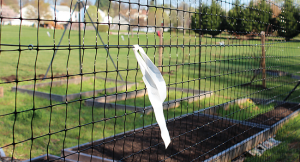Bee a Hero: Save Pollinating Plants From Deer Damage
Next time you bite into an apple, or sip a cup of coffee, thank a bee. Without bees, families would not be able to consume nearly as much of the food crops that we serve daily. Bees pollinate 80 percent of the world’s plants; and without bee pollination, we would lose an annual average of $20 billion worth of agri-culture. Bees feed on the pollen and nectar of certain plants for survival; which is why gardeners must protect pollinating flowers from wildlife damage to save bees. Since bee colonies are declining at an alarming rate, gardeners should install plastic and metal deer fencing around flowers to keep deer and other wildlife away from flowerbeds and bee hives.
 Poly deer fence (plastic) is recommended for gardens with light to moderate deer pressure. Gardeners may be hesitant to use plastic fences around landscapes; but with a certified breaking strength between 650 lb/sq.ft. to 1,400 lb/sq.ft, and a life expectancy of 15-20 years, it’s no wonder why gardeners choose to use this type of garden fence for deer control.
Poly deer fence (plastic) is recommended for gardens with light to moderate deer pressure. Gardeners may be hesitant to use plastic fences around landscapes; but with a certified breaking strength between 650 lb/sq.ft. to 1,400 lb/sq.ft, and a life expectancy of 15-20 years, it’s no wonder why gardeners choose to use this type of garden fence for deer control.
When gardeners are dealing with heavy deer pressure and critter damage, they turn to steel fences with PVC-coating. Steel Fences are stronger than plastic fences and stand up against chewing animals. Not only does the PVC prevent chew marks from reaching the fence material, but it protects the fence from UV-damage and harsh weather conditions. While metal fencing is strong enough to stop deer, rabbits and coyotes, it is not recommended for bear management. (See electric fencing for bear control.)
Gardeners can grow a variety of plants around a deer fence to help bees pollinate that are also deer resistant including aster, marigolds, garlic, peppers, sage, rosemary and lavender. Be a part of the movement to save bees by protecting pollinating plants in the garden.
DeerBusters.com has been leading the fencing industry for over 30 years with reliable DIY garden fence in poly and metal fence materials for homes, farms, forests, colleges, orchards, vineyards, and gardens.
Jennifer Smith, Deerbusters Deer Fence
The Design of the Eco Bee Box
“Bee Sanctuary” Long-box This horizontal hive is completely Langstroth compatible with options that allow many frame sizes – deep, medium, or mini comb frames.
Medium or Deep Style – Can be made as a “deep” box or a “medium” box.
Reversible Base & Stainless Locking-clips – The bottom board can be reversed with the use of stainless-steel locking-clips. This change allows inspections out of the bee’s flight path.
Flip-up Lid with Covered Porch – Gate strap hinged locking lid with a covered porch.
Aluminum Rabbets – Rabbets that can withstand abuse, made of aluminum.
Copper or Aluminum – Corners and accents in solid copper or aluminum.
Follower / Isolation Boards – Isolation boards are used to divide this hive into multiple colonies, or for queen rearing and banking.
Adding Supers – A medium super will fit comfortably under the lid and still close.
Extensions – For those using the “medium” size, ½ box and full box extensions are available allow-ing use of a “deep” frame in a “medium” hive.
Inner Half Lids with Top En-trance and Stainless-Steel Entrance Reducer – Upper and lower entrances give better ventilation both during winter and summer. Half lids allow specific inspections without disturbing the entire colony.
Cedar Embellished for Beauty – Cedar is the wood of choice as it holds up well in the elements. A beautiful hive is for the beekeeper and those that are looking in. Interest begins with “catching the eye” of those looking.
Comes mostly assembled. Any part can be easily repaired if damaged.
Price $500 and up.
Can be found on Amazon.com and Eco-BeeBox.com.










